There was a steady stream of Chinese buyers at the Irish meat stand at SIAL, the major food exhibition in Shanghai this week, which coincided with an Irish trade mission led by Minister for Agriculture Michael Creed.
Steven Lin of Jiangsu Holly, a company importing 20 to 30 containers of beef per month to populous central China, was up to date with the latest Irish beef factory approvals for export to his country.
“We usually buy from Latin America, but the quality is not always good,” he told the Irish Farmers Journal. “We want to try Irish beef.”
Machlin Liao, a meat trader with Lya Food in Hong Kong, also visited the Irish stand. “I know Irish companies, we already have contacts with them for pork,” he said. Feedback from his customers is that Irish quality is good, and they, too, are willing to try beef. However, “I think the price should go down,” he warned. “In the Chinese market, competition is very tough.”
This was evident immediately across the way, where the Brazilian beef stand dwarfed the Irish one in size and crowding – a reflection of Brazil’s leading position in this market. One of the companies exhibiting, Naturafrig, is not currently approved to export to China. “China will inspect some plants for approval this year,” said Victor Hugo Capuci of Naturafrig, which has two factories on the list. “It’s very rare; the last time was in 2015,” he added. “There is a lot of interest because Brazil has cheaper product than Australia.”
The other beef powerhouse in China was present at the True Aussie stand. Michael Finucan of Meat and Livestock Australia said Ireland and Australia would be in competition in some sections of the Chinese market because they have “the same green story”.
Finucan, just like Irish exporters, says his product has “quality you can stand behind” for buyers requiring consistent standards. Yet the “huge potential” of China is one market among others for Australia, with Korea and Japan also lucrative options, and he did not expect Australia to ramp up shipments to China significantly – especially as a Chinese ban on hormone-grown beef imposes forward planning and higher costs on farmers setting aside cattle for this market.
The cheaper end of the Chinese market is occupied by Indian processors exporting buffalo meat through Vietnam, such as HMA, also an exhibitor at SIAL.
Its chair, Mohammad Ashraf Qureshi, told the Irish Farmers Journal that his company shipped cuts from 5,000 animals each day to China and was only one of many Indian processors in this business.
Read more
Filling the 80m tonne Chinese meat gap
China to ‘rewrite the rules’ of agri food trade
There was a steady stream of Chinese buyers at the Irish meat stand at SIAL, the major food exhibition in Shanghai this week, which coincided with an Irish trade mission led by Minister for Agriculture Michael Creed.
Steven Lin of Jiangsu Holly, a company importing 20 to 30 containers of beef per month to populous central China, was up to date with the latest Irish beef factory approvals for export to his country.
“We usually buy from Latin America, but the quality is not always good,” he told the Irish Farmers Journal. “We want to try Irish beef.”
Machlin Liao, a meat trader with Lya Food in Hong Kong, also visited the Irish stand. “I know Irish companies, we already have contacts with them for pork,” he said. Feedback from his customers is that Irish quality is good, and they, too, are willing to try beef. However, “I think the price should go down,” he warned. “In the Chinese market, competition is very tough.”
This was evident immediately across the way, where the Brazilian beef stand dwarfed the Irish one in size and crowding – a reflection of Brazil’s leading position in this market. One of the companies exhibiting, Naturafrig, is not currently approved to export to China. “China will inspect some plants for approval this year,” said Victor Hugo Capuci of Naturafrig, which has two factories on the list. “It’s very rare; the last time was in 2015,” he added. “There is a lot of interest because Brazil has cheaper product than Australia.”
The other beef powerhouse in China was present at the True Aussie stand. Michael Finucan of Meat and Livestock Australia said Ireland and Australia would be in competition in some sections of the Chinese market because they have “the same green story”.
Finucan, just like Irish exporters, says his product has “quality you can stand behind” for buyers requiring consistent standards. Yet the “huge potential” of China is one market among others for Australia, with Korea and Japan also lucrative options, and he did not expect Australia to ramp up shipments to China significantly – especially as a Chinese ban on hormone-grown beef imposes forward planning and higher costs on farmers setting aside cattle for this market.
The cheaper end of the Chinese market is occupied by Indian processors exporting buffalo meat through Vietnam, such as HMA, also an exhibitor at SIAL.
Its chair, Mohammad Ashraf Qureshi, told the Irish Farmers Journal that his company shipped cuts from 5,000 animals each day to China and was only one of many Indian processors in this business.
Read more
Filling the 80m tonne Chinese meat gap
China to ‘rewrite the rules’ of agri food trade






 This is a subscriber-only article
This is a subscriber-only article











SHARING OPTIONS: